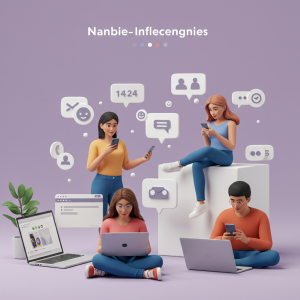The Importance and Success of Influencer Marketing and How You Can Make It Work

Influencer marketing wasn’t just another buzzword–these influencers have changed how companies interact with their audiences. Today, performers on Instagram or TikTok have become a reliable force for product marketing, and every recommendation they make becomes a weapon due to their deep connections with people who are willing customers that listen carefully and react positively.
But what really is the secret to the success of influencer marketing? Is it their compact communities or perhaps also how they manage to convey honest yet engaging content? This blog deconstructs the magic of influencer marketing, walks you through why it works, and then shows your company how to get it done too.
The Importance and Success of Influencer Marketing

Trust lies at the core of influencer marketing. Unlike traditional ads, where buyers are naturally suspicious of a corporate agenda, influencer endorsements feel more personal. They are talking from experience, and people believe their words. The trust in them is extraordinary.
Influencers in a different class: Influencers often share snippets of their daily life, struggles, and victories. This relatability brings a closer sense of connection with fans compared to an anonymous brand. For example, when a fitness influencer shares their favorite protein powder, it doesn’t feel like a commercial, but rather a legitimate suggestion.
Authentic content: Audiences are not attracted to influencers by scripted advertisements; they follow creators for their honesty. Quality influencers seamlessly weave marketing into the fabric of their content. As an example, beauty influencers often demonstrate a product during a tutorial — making the ad perfectly natural and in line with what they do anyway.
Pro Tip: When enrolling influencers in your campaign, make sure their personal values and content style match with your brand. Authenticity is not something that can be pretended, and fans will smell out any false cooperation.
The Power of Targeted Reach
Another contributing factor to influencer marketing’s success is its targeted reach. Influencers are almost always experts in particular fields, whether that’s tech, fitness, child-rearing, or gaming. This allows a brand to intersect with very specific groups of people who have already bought into that influencer’s expertise.
Why Niche Counts: A sustainable brand that teams up with a like-minded eco-lifestyle influencer guarantees its product will be seen by people in touch with nature. The advantage over traditional strategies is clear when you consider the costs of TV commercials and the complexity of reaching such a niche audience.
An example: A skincare brand promoting an anti-acne serum with a beauty influencer targeting teenagers and young adults is far more effective than a general TV ad aimed at all age groups.
Micro vs. Macro Influencers
There’s a choice between micro-influencers (followers 1k–100k) and macro-influencers (100k+ followers). Micro-influencers have a smaller reach but often achieve higher response rates and establish more personal relationships with their followers. Macro-influencers have a broader reach but lower levels of interaction.
Trivia: Research shows that micro-influencers achieve up to 60% higher user engagement than their macro colleagues. Why? Community size is smaller, so it feels more personal and mingled.
Social Proof that Makes Decisions
Humans tend to look to see what others are doing and copy them. When audiences witness personally cherished influencers pushing a product, it symbolizes that the product is both credible and currently ‘in’. The resulting chain reaction can be greatly enhanced by social proof. learn more about What Is Influencer Marketing.
Why This Works So Well:
- FOMO (Fear of Missing Out): Hearing from others about a product arouses curiosity. If several influencers are promoting it, people tend to think, “If everyone else loves it, I should give it a try myself.”
- The Bandwagon Effect: Shoppers dream of being part of a group, and influencers’ trends create that feeling of kinship. Look at viral products such as the jade roller or “TikTok leggings” — chatter turned thousands of viewers into customers.
Pro Tip: Use hashtags and challenges when working with influencers. For example, in the #ASOSHaul campaign, not only do you give exposure to your product, but user-generated content can also serve to strengthen social proof.
High-Quality, Immersive Storytelling
People don’t like to be sold to, but everyone loves a good story. Influencers excel at integrating brands into narratives that feel natural and compelling. Whether it is an unboxing video, “day in my life” vlog, or try-on haul, the storytelling format is different from traditional ads.
Formats for Storytelling:
- Before-and-After Transformation: Fitness influencers show off their beach bodies while crediting your product for their progress, subtly suggesting how it might work out in the viewer’s favor too.
- Lifestyle Integration: For instance, food bloggers make videos and posts with familiar “at-home recipes” that include sponsored brand products.
Case Study: GoPro’s effectiveness at using influencers can be seen in their adventure campaigns, where creators shoot stunning video with GoPro cameras. The result not only shows off product functionality but also has stunning visuals that resonate deeply with the company’s daring customer base.
Measurable ROI and Data Insights
The difference between influencer marketing and other forms of promotion is its trackable effect. Brands can use engagement tools like Google Analytics or Instagram’s Insights to monitor engagement, clicks, and conversions. You can get a bird’s-eye view of campaign performance.
Key Metrics to Track:
- Engagement rate (likes, comments, shares)
- Click-through rate (CTR) (number of people clicking on links or swipe-ups)
- Conversion rate (how many users purchased based on the influencer’s content)
Real Stats: According to a Nielsen study, businesses generate an average of $5.78 for every $1 they spend on influencer marketing.
Advanced Features: Brands can also use influencer marketing campaigns for A/B testing. For example, a company can work with two different-tone influencers (e.g., a serious vs. playful approach) and see which one engages the audience most effectively.
How to Start Your Influencer Campaign

If you’re ready to dip your toe into influencer marketing, these steps will help get you started on the right foot:
- Define Your Goals: Are you trying to promote sales, make your brand more well-known, or rather get followers? Design your campaign accordingly.
- Find the Appropriate Influencers: Tools like BuzzSumo and Upfluence can help you find influencers in your field. Look at engagement rates, audience fit, and credibility, not just follower numbers.
- Decide on Your Budget: Are you working with micro-, macro-, or celebrity influencers? Each level has its own pricing strategy. Consider how many influencers your budget allows you to work with.
- Create Clear Campaign Guidelines: While influencers thrive on creative freedom, give them a framework of expectations, messaging, and brand values that must be communicated.
- Monitor Feedback and Adapt: Keep your eye on parameters like reach, engagement, and conversions. Based on results, fine-tune future campaigns.
Now It’s Your Turn to Lead
Trust, targeted audiences, storytelling, and measurable results are key to the success of influencer marketing. This method of marketing builds a bridge between your brand and your customers, offering a direct and authentic way to communicate.
In short, no matter if you are a small startup or an established company, proper management of influencer marketing can give your brand the chance to shine on a whole new stage.





